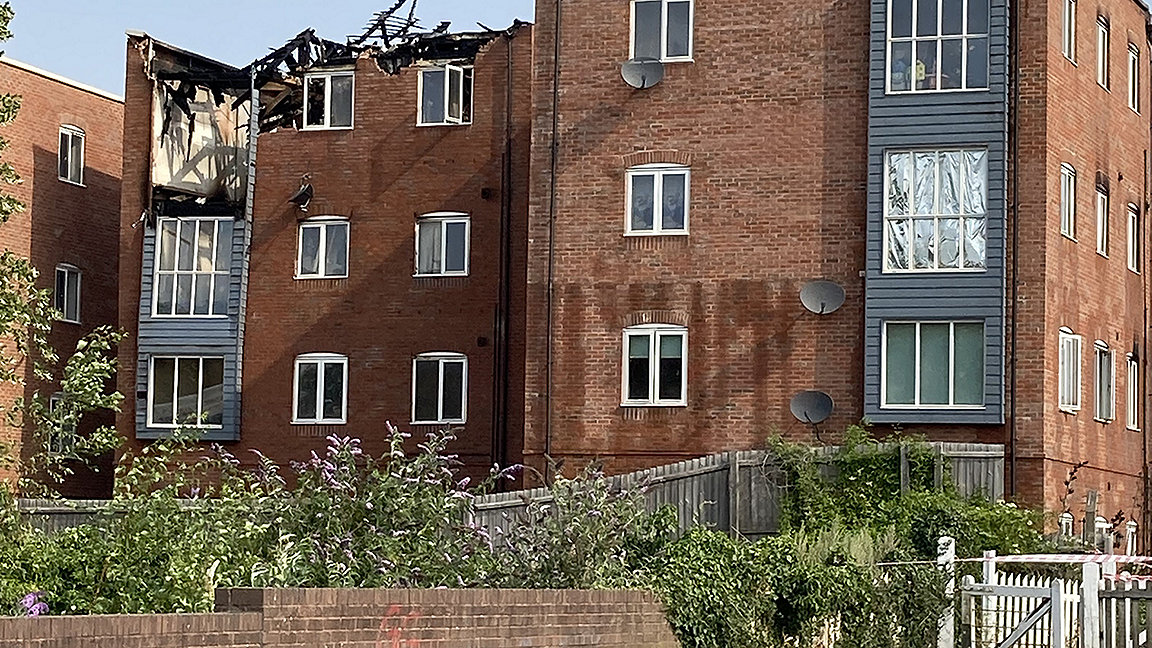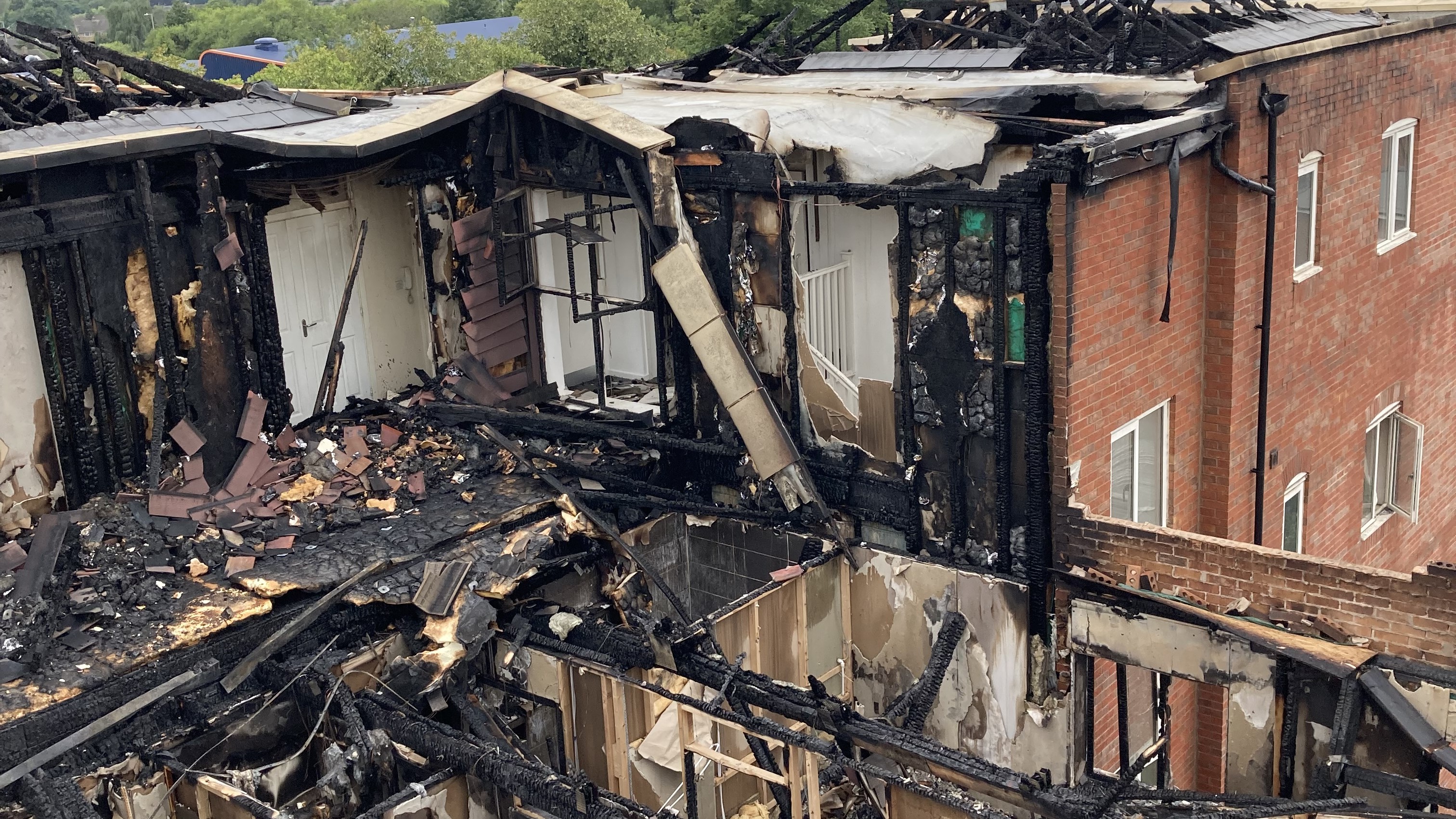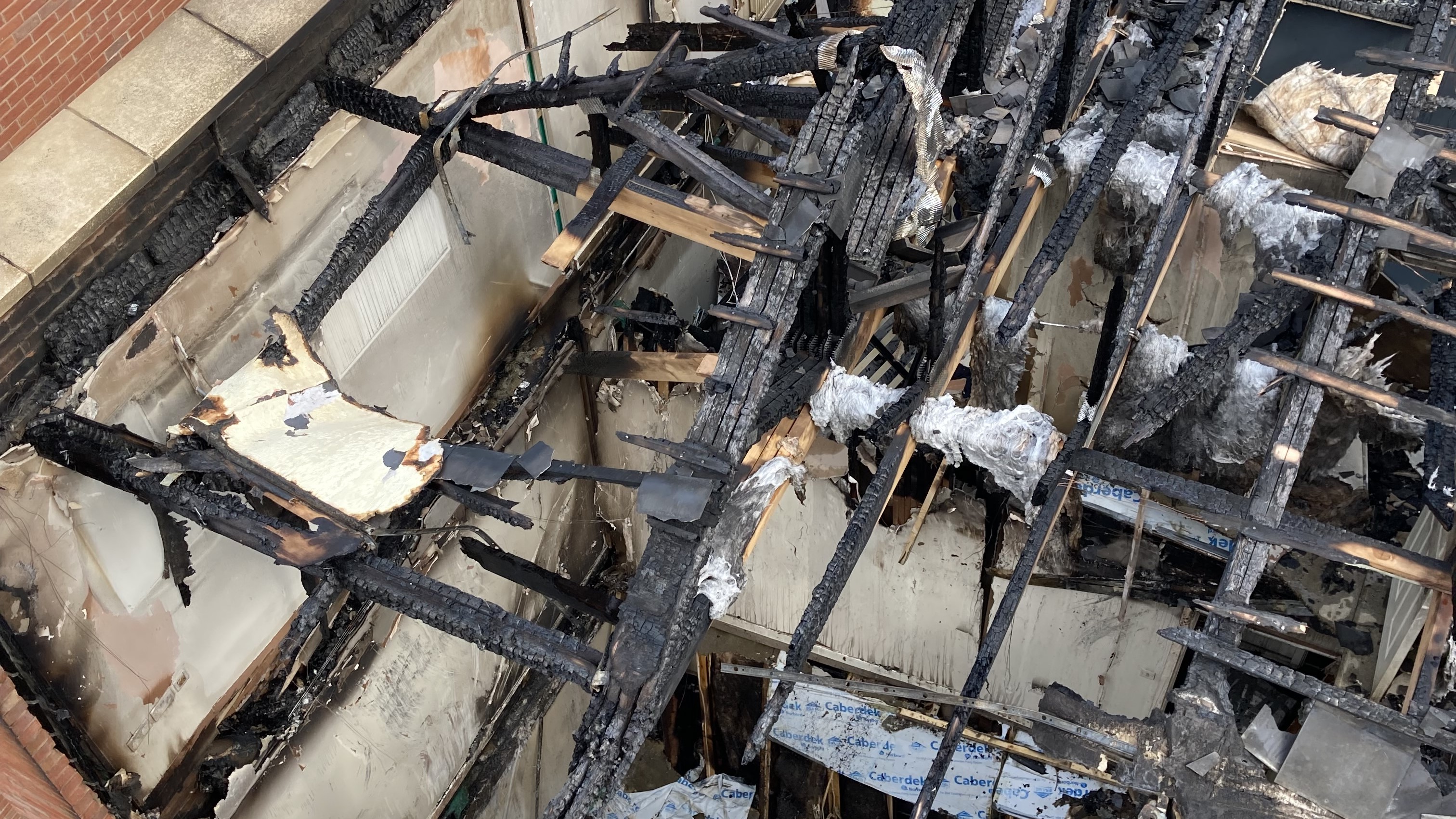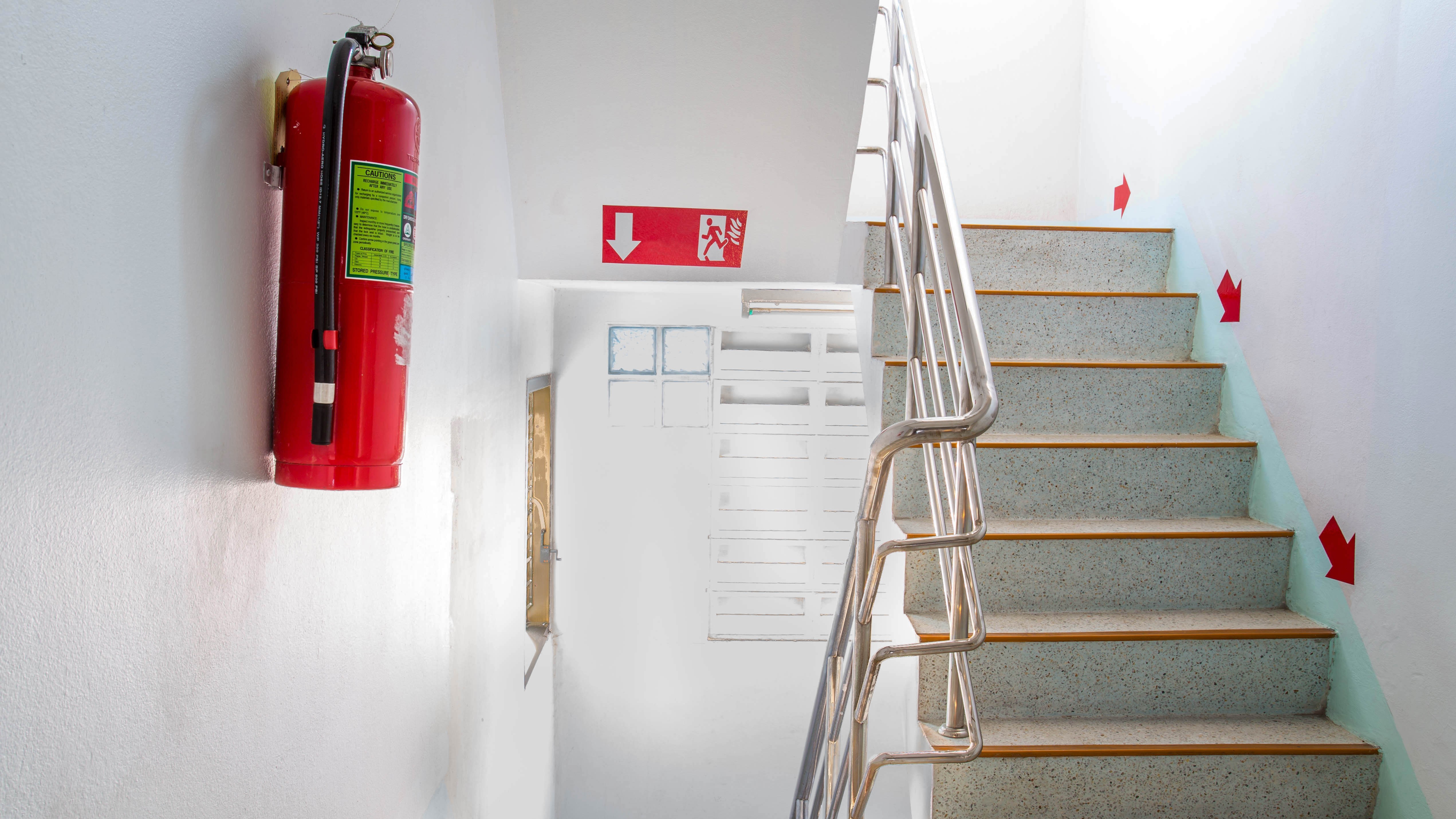
The rear block on the left was the origin of the fire © Boston Borough Council
Tuesday 19 July 2022 was a very warm day in the UK, and temperatures at Coningsby in Lincolnshire reached 40.3°C. Meanwhile, the fire and rescue service (FRS) in nearby Boston was called out to Charleston Terrace, where there was a severe blaze at a block of flats.
A bush near the building had ignited, melting the plastic ventilation air-bricks in the underfloor void, and the fire had spread into and through the cavity behind the masonry skin via the timber frame and breather membrane covering.
The FRS was called at 1.55pm and were on site in 15 minutes, when firefighting commenced. They also asked the gas distributor Cadent to disconnect gas services, which took several hours.
The external fire was quickly dealt with, but then the service identified smoke coming from the building at higher level. All the residents were evacuated.
Explosion renders building unstable
Despite continued firefighting, the fire spread could not be prevented. Concerned about the stability of the structure, the FRS contacted Boston Borough Council, as local authorities are obliged under the Building Act 1984 to deal with dangerous structures in their area.
The on-call building control surveyor – a council colleague of mine – arrived on site at 8.25pm. They noted that the roof covering on the rear four-storey section of the block on Longview Terrace, which was the main point of the fire, had gone and that charred trusses were visible.
At around 9.25pm there was an explosion in the top flat of the building's three-storey section, although the cause still remains undetermined as the gas supply had been disconnected by this time. The roof of the flat then collapsed along with the side wall and part of the front wall.
The smoke continued to get worse, and there was a concern that the four-storey section could explode as the three-storey section had. Indeed, the fire did eventually break through the four-storey section's roof. Although there was some damage to adjacent buildings, it was not possible to assess the extent at this stage.
At 1.20am, speaking with the FRS incident commander, the surveyor agreed that they could be of no further help until the fire was under control, and therefore would return at the start of work the next day. A safety cordon and road closure enforced by police remained in place.
Managing competing demands around dangerous structures
The incident was handed over to me as the council's senior building control officer by the on-call surveyor at 8.45am on 20 July, and I was on site from 9.30am. The FRS now considered the fire out, but the road closures by Lincolnshire Police remained in place.
Liaising with the FRS incident commander, I inspected the smouldering remains from aerial ladder platforms (ALPs) on two fire engines at the scene.
The rear block had visible damage from the ground to the top storey, with the floors burnt away and the external masonry skin unsupported for its entire height in close proximity to an adjacent block. All roof structures had been lost and, where it was visible, the timber frame was heavily charred.
From my inspections I considered the building immediately dangerous under section 78 of the 1984 Act, and advised the incident commander. However, as this had been classified as a major incident, I also sought a second opinion from the council's structural engineer.
While waiting for the engineer to arrive, I updated my manager and had conversations with the various stakeholders, including representatives of the building owner and management company, as well as Lincolnshire Police, the highways department, owners of the adjacent buildings and the council's senior leadership team.
I was also in touch with the Port of Boston, which runs a freight service on a rail line passing the southern part of the site.
These types of incident can be very stressful, with the various stakeholders' demands all requiring consideration. Until I served formal notice of my intention to remove the immediate danger, I was unable to take any action. However, the police were keen to take officers off the three road closures, and the port needed to get its rail line operational as soon as possible.
Yet, with the building in an unstable condition and the vibrations that the trains would cause, it was not possible to reopen the line. Similarly, the police presence was necessary to deter unauthorised entry to the site. I ensured I maintained regular contact to keep all stakeholders updated.
'Until I served formal notice of my intention to demolish the building, I was unable to take any action'
Council endorses need for demolition
The fire service made contact with the building management company, which represented all the flats in the development, and it in turn arranged for loss adjusters to visit the site later in the day. Fortunately, the adjuster attended at a similar time to the structural engineer and both carried out inspections from the ALPs.
Although the loss adjusters recognised the severity of damage and the potential risks it posed, they said they would not be in a position to take any action until the following week, for administrative reasons. I advised that this was unacceptable, as the building was immediately dangerous.
The structural engineer confirmed that the building could not be saved, concluding that the whole structure was dangerous and the most suitable course of action would be total demolition. This recommendation would be followed up in a detailed report, supplied the following day.
This information was relayed to my line manager and I was given full support by the council's leadership team to take the necessary action. I prepared a section 78 notice and served it on the building owner.
Shortly after 5.30pm on 20 July, although the FRS had deemed the fire out more than 12 hours previously, an increase in wind speed had reignited one of the parapets.
I had contacted my emergency contractor, and it delivered fencing to secure the site at 6pm. This was put up to provide a secure cordon around the building, while allowing the FRS room to continue damping down the reignited blaze.
The demolition works would be too complex for the emergency contractor, though, so a local demolition contractor with the necessary expertise, knowledge, and skills agreed to attend late morning the following day.
I left the site at 10pm, at which time the cordon was in place around most of the site; an opening was left for emergency service use while the FRS and police remained in attendance.
'The loss adjusters would not be in a position to take any action until the following week, which I advised was unacceptable'

A view from ALP on London Road, the morning after the fire © Boston Borough Council

A view from ALP on Longview Terrace on 20 July © Boston Borough Council
Stakeholders meet to determine course of action
On 21 July, the FRS called a meeting with Lincolnshire Police, the demolition contractor and Network Rail, which I also attended.
The FRS chaired the meeting and advised on its required outcomes, namely:
- to confirm that the fire was out
- to obtain input from the other stakeholders
- to hand the site over to the owner, or another organisation such as the local authority building control team
- to agree whether the FRS needed to remove personnel in full or in part from the incident.
The FRS incident commander stated that, as the fire had now been out again for 15 hours, that the service could vacate the site. He also said they would be willing to leave a pump in place should the demolition contractor require, but the contractor said this would not be necessary.
There was some debate about public safety, but with support from FRS, the police agreed to remain on site until the building was taken down. Dust suppression would be put in place during the demolition and as the building had only been constructed in 2016, it was reasonable to assume there was no asbestos present.
However, as the debris pile would contain personal possessions and former occupants and others may try to get on to the site, it was felt that a continuing police presence would help deter people.
I advised that the building was immediately dangerous from a building control perspective, and that a section 78 notice had been served on the building owners.
Several areas of the building were visibly unstable and due to the fire spread through the cavities, and the unknown extent of damage to the timber-frame structure behind the remaining masonry facade, the only way to ensure public safety was to demolish the remains.
Network Rail also confirmed it would maintain a watching brief on the process.

The side of the building from ALP on Longview Terrace © Boston Borough Council

Firefighting had to continue when the blaze reignited in the parapet void © Boston Borough Council
Demolition proceeds swiftly
Obtaining a quotation and seeking authorisation from the senior leadership team, I was able to appoint the local contractor to carry out the demolition. The council's contract procedure rules were followed, while taking into account the need for specialist input and the significant risk of not acting with urgency.
As speed was of the essence, demolition began on site on the evening of 21 July and the bulk of the work was completed by 4.30am on 22 July, with the building reduced to a pile of debris.
Dust suppression was in place, and no complaints were received in relation to the noise as the adjacent buildings had been evacuated. Work continued until 29 July to remove waste arisings and tidy the site.
All arisings were loaded into lorries and taken to landfill in Cambridgeshire, where the closest facility that would accept the debris was based. Security remained on site in Charleston Terrace during the hours that work was not taking place, and throughout the weekend to deter unauthorised access.
I carried out regular inspections during the works and updated stakeholders as necessary informing the Port of Boston, for instance, that it could reinstate its freight service as planned on the afternoon of 22 July.
However, the highways department was not permitted to reopen the road until a week later as the waste lorries needed sufficient space for loading.
Evacuated residents have to be kept informed
Meanwhile, the communications teams from the various agencies involved – the local authority, FRS and police – were engaging with residents by email, press releases and social media.
It was extremely difficult to tell residents that they could not return to their homes, and that the building was to be demolished along with their possessions, since they had watched from the cordon each day. Given the potential risk to life, however, no access to the building was possible to recover belongings.
Alongside this, the council's housing team provided initial support to residents and helped organise temporary accommodation. This responsibility then moved to the estate management company and insurers to support longer-term housing arrangements.
'It was extremely difficult to tell residents that they could not return to their homes, and that the building was to be demolished'
Major incident offers valuable lessons
Fortunately, large-scale events that endanger structures like this are rare. But skills gained when attending more minor events, such as cars colliding with buildings, will be put to good use.
As with any other incident, I carried my notebook at all times to take copious records throughout, including names, contact details and timings. Photographs are also helpful, both during and after an incident; in this case, I took more than 130.
This was the first time I had needed to instruct a demolition contractor, and I made sure I followed the council's procurement rules. It is not usual to require senior leadership involvement, but I was reassured by their support in this process.
However, I would suggest you check your own employer's procurement rules, and ensure you have contingencies in place for events like this.
Given the sheer number of calls I received from stakeholders, I would recommend that a minimum of two surveyors are on site during such incidents.
You should at least have a colleague on standby to lighten the load and allow for regular breaks. And remember that phone batteries don't last forever, so make sure you have a way of charging on the go.
I also found that the general public do not like cordons, and there were numerous breaches or attempted breaches throughout the incident, even given the dangers present. Out-of-hours security was therefore essential.
Even though this was a relatively new building that met the requirements of the current Building Regulations, it could not be saved. The unusual way the fire breached and travelled through the cavity meant that the horizontal barriers were quickly rendered ineffective, allowing the fire to spread up and throughout the building.
If I were asked what could have prevented or reduced the impact, I would say omit any soft landscaping close to a timber-framed building, to provide a fire-sterile strip.
The landscaping around similar residential blocks on this development is reasonably barren, with just well-kept grass, whereas the affected block had acted as the show flat for the development and the heavy planting had been provided as a selling feature.
Under section 78 of the Building Act 1984 – which covers emergency measures for dangerous buildings – if it appears to the local authority that a building or structure is in such a state as to be dangerous and immediate action should be taken, we can do so, and recover from the owner the costs reasonably incurred.
In this case, we recovered our expenses in full not much more than two months after the incident. It was not straightforward, and we were challenged by the loss adjusters in several areas; however, with reference to the notes I had taken at the time, we were able to provide sufficient justification.
Paul Smith is a senior building control surveyor at Boston Borough Council
Contact Paul: Email
Related competencies include: Building control inspections, Inspection, Legal/regulatory compliance

